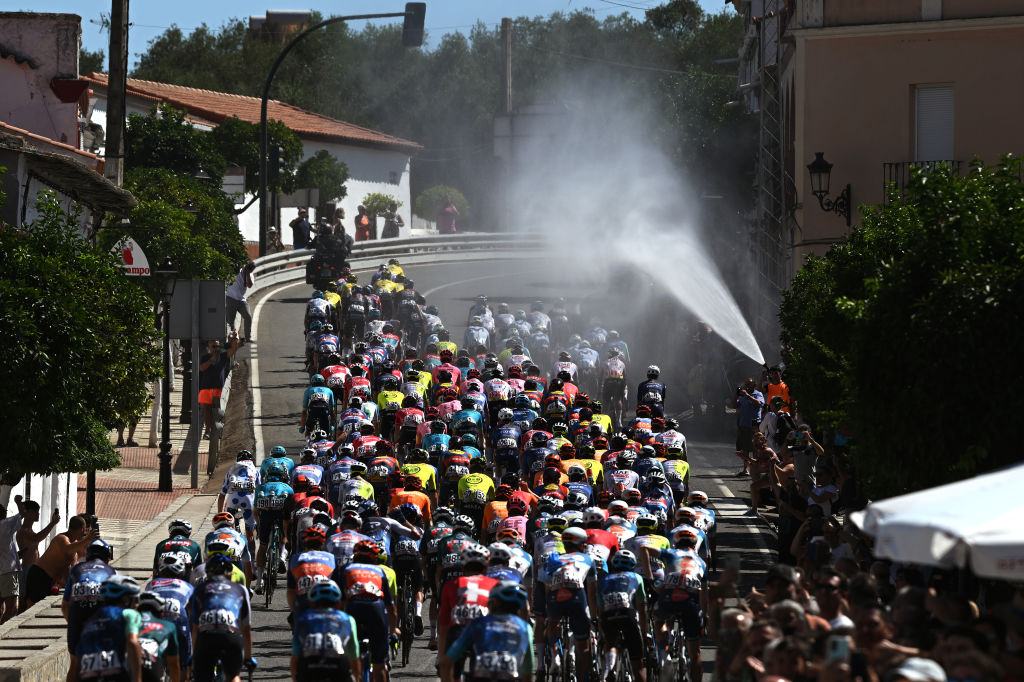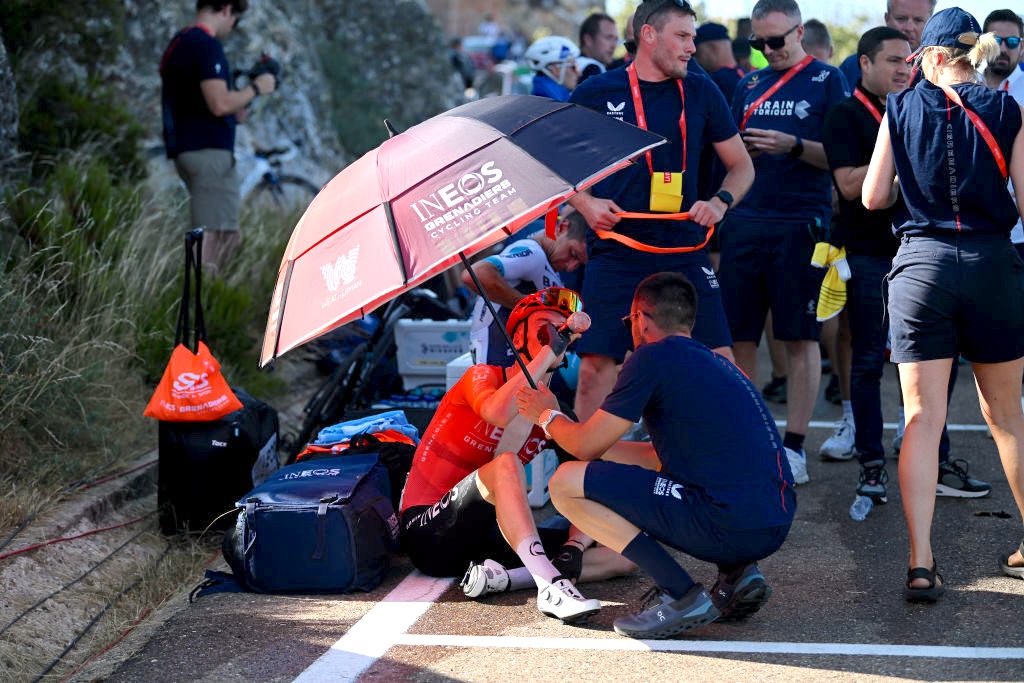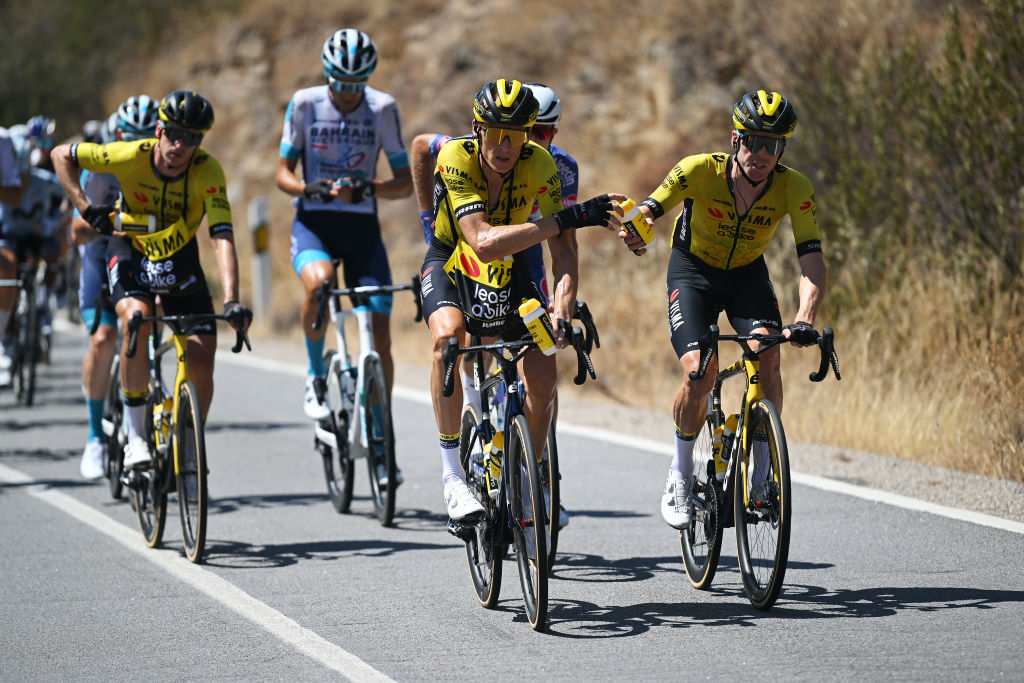The heat is on: How the Vuelta a España peloton is battling the first week’s intense temperatures
Harsh weather sparks calls for future changes in race formats

Very hot weather has almost always formed part of the Vuelta a España whenever it ventures into the southern half of the country. While this year is no exception, there’s been no let up to date in the heat, either, making the effects much more noticeable.
Temperatures so far have peaked at around 40°C on stage 4, but ever since the race left Lisbon, maximums have rarely dropped out of the mid-30s. On stage 5 temperatures dipped slightly to around a high of 37°C at the finish in Seville. But that wasn’t enough to stop the effects of the heatwave on the peloton, which made its way at a notably subdued pace across the rolling plateaus of south-west Spain for most of the day.
The effects of the heat are everywhere, though, and not just during the stages themselves. Riders wearing ice jackets at the start and finish were once a rare sight, but are now all but normal at Vuelta salidas. The same goes for ice baths, tucked away discretely inside team vehicles for a quick post-stage dip.
Then during the stage, it’s not just about soigneurs being placed at increasingly shorter intervals to hand out bidons to ever-thirsty riders. The fans have got in on the act, too, with hoses placed on the side of the road - mostly set to spray rather than send out a potentially dangerous more powerful single jet of water - periodically drenching the riders.
It’s important to emphasise that heat is nothing new in the Vuelta a España. Back in 2014, Fabian Cancellara claimed he’d lost 4.5 kilos in a single stage in searing heat in the south of Spain at the Grand Tour. For years, the practice of putting a lettuce leaf under a race cap, because of the plants’ alleged benefits at lowering body temperatures (and back when helmets were not obligatory), were common amongst certain groups of pro riders in the Vuelta as well.
But as temperatures have steadily risen across the globe, in bike racing at least, those homespun methods of cooling down like the lettuce leaves have wilted away, while practices to combat the heat have become steadily more professional and more widespread.
On stage 4 of the 2024 Vuelta a España, it seemed like a new spike in activity to fight the heat was reached.
Get The Leadout Newsletter
The latest race content, interviews, features, reviews and expert buying guides, direct to your inbox!
“The team has never given out so much water as on stage 4,” experienced EF Education-EasyPost Sports Director Tom Southam told Cyclingnews. “We had eight people on the sides of the roads, we were constantly going up and down giving out bidons and ice, not to individual riders but for riders to take up to everyone else. Then we were constantly refilling the cars with more supplies.
“The way stage 4 was designed, too, meant there were two early climbs that got everybody hot and you didn’t have much shade there to start with. But then you went into the middle of the stage which was a real cauldron.
“There was no shade whatsoever, and they were doing a low speed too, which made it worse. Then in the final there was a climb - no shade, a plateau - and then the final climb with cement surfaces for a lot of it, reflecting the heat.
“So it wasn’t like you hit a descent at any point to cool down before you went up the last mountain. And you couldn’t race hard all day because it was so hot. You were stuck out there all day in the heat, and that’s why we were behind schedule at the finish.”

Heat adaption strategies like putting on more clothes at training camp, or simply getting on the rollers in a greenhouse with a heater at full blast, date back to the 2000s. On the road, Bradley Wiggins was one frontrunner of such a strategy, training in his garden shed with a heater to imitate the Spanish weather prior to the 2011 Vuelta, where he finished second.
But now with rising temperatures, these strategies have become much more formalized and frequent. Or as Southam puts it more directly, “It’s not revolutionary stuff, but it’s becoming more applicable to society now because the planet is getting so fucking hot".
“I was reading the other day that without our adaption [in everyday life] to heat in the last 20 years, x-amount more people would be dying from the effects of the higher temperatures. So if you’re racing in it, you have to be sure you have adapted, too.”
Things will not change, almost certainly, until stage 10, when the peloton moves 1,000 kilometres north to Vigo and northern Spain, where temperatures are currently running at around 20°C, nearly 15-20 degrees cooler than in the south. Until then, according to Spanish state weather researchers Aemet, temperatures are forecast for 34°C in Yunqera’s stage finish on Thursday, 39°C for Cordoba on Friday, 36°C for Cazorla on Saturday and 35°C at the end of a stage in Granada on Sunday, which also includes three major mountain passes.
Asked how this incessant heat was affecting the racing, UAE Team Director Joxean Fernandez Matxin had a clear answer. “It changes things a heck of a lot. It’s 36 degrees and it’s the morning and you’re feeling hot already, aren’t you?” he rhetorically asked Cyclingnews before stage 5.
“Imagine what it’d be like with 43 degrees in the middle of the afternoon with no breeze, and riding on the bike for six hours," he continued.
“Not everybody handles that kind of temperature well, but it affects things a lot, it changes things a lot. I think in my 30 years of directing teams, I don’t think I’ve ever handed out so many bidons of water.
“We had to put water for the showers in the fridge beforehand to cool it down. We’ve being buying ice in gas stations with a refrigerated truck.
“It is a vicious circle though, because when it’s so hot, you dehydrate even more because you don’t eat as much. So your body doesn’t assimilate the heat as well.”

One effect has its slightly amusing side, Southam says. “Normally you go through so many feed zones where the riders say, 'I couldn’t get the musette because of this or that' or whatever excuse. Yesterday there wasn’t a single missed musette…”
More seriously, the usual protocol of keeping EF Education-EasyPost's Richard Carapaz protected from the heat was intensified.
“We’ve got Richie as our leader, and it was, ‘OK what does Richie need to be ready for the final climb at this point and that point'. So make sure you collect it, give it to him, share it out.” In the hotter weather, such support becomes even more critical.
The riders in breaks are more fortunate, Southam says, because they have a following car close by so they can top up easily on water. But for the GC riders like Carapaz or his own racer Adam Yates, Maxtin points out it was much harder to know what the real effects of a climb had been on them, as both lost time on Villuercas. Such is the heat that the high temperature distorts riders’ performances, he argues, and as a result, it’s much trickier to know which riders were genuinely showing good or poor condition.
“It’s very difficult. There are people who handle the heat better and who just need a shower to recover, others who suffer a whole lot more and who don’t recover even if they rehydrate fully.
“There were a lot of riders who suffered on stage 4, not just [UAE Team Emirates co-leader] Adam Yates. Lots of them couldn’t handle the pace even before the last main climb of the day.”
As for whether action should be taken by the organisers to try and lessen the effects of the heat, Southam says, “I’m super curious as to why there’s no activity about this in terms of extreme weather".
"In Australia, we had some 40-plus degree days and everybody was ‘Let’s make the race shorter, let’s do this or let’s do that'. Here I was talking to the riders after the stage and nobody says anything."
In the past, Spanish races adapted to the extreme heat. When the late climbing legend Federico Martin Bahamontes was the director of the Vuelta a Toledo, an amateur race which folded a few years back, the entire event was held in the mornings precisely to avoid the heat of central Castille.
Matxin argues that the increasingly high temperatures should cause race organisers to reflect on how to design their events, particularly in the summer months.
“There really is a lesson here. We should minimize the number of hours in extreme heat. Possibly, though, it won’t be until somebody suffers some kind of heat stroke and gets carried off in an ambulance, that we see any real action taken.
“But I hope this gets sorted out before. Because racing for so many hours through places where it was 43 degrees - I don't think that is healthy for anybody.”
Get unlimited access to all of our coverage of the 2024 Vuelta a España - including breaking news and analysis reported by our journalists on the ground from every stage as it happens and more. Find out more.
Alasdair Fotheringham has been reporting on cycling since 1991. He has covered every Tour de France since 1992 bar one, as well as numerous other bike races of all shapes and sizes, ranging from the Olympic Games in 2008 to the now sadly defunct Subida a Urkiola hill climb in Spain. As well as working for Cyclingnews, he has also written for The Independent, The Guardian, ProCycling, The Express and Reuters.
